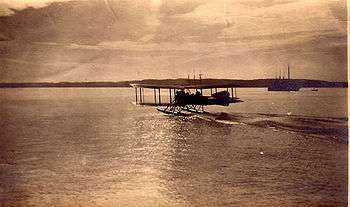Friedrichshafen FF.49
| FF.49 | |
|---|---|
 | |
| Role | Reconnaissance |
| Manufacturer | Flugzeugbau Friedrichshafen GmbH |
| First flight | 1917 |
| Introduction | September 1917 |
| Primary users | Kaiserliche Marine Finnish Air Force Polish Air Force Danish Navy |
| Number built | 240 |
| Developed from | Friedrichshafen FF.33 |
Friedrichshafen FF.49 was a German, two-seat, single-engine float-plane designed by Flugzeugbau Friedrichshafen in 1917.
Variants
- FF.39
- Two-seat reconnaissance float-plane, powered by a 150 kW (200 hp) Benz Bz.IV water-cooled 6-cylinder piston engine. 14 built.
- FF.49B
- Two-seat bomber float-plane. 25 built.
- FF.49C
- Two-seat reconnaissance float-plane.
Operators

- Royal Danish Navy
Danish Air Lines (postwar), (one FF.49C) 
- Finnish Air Force (four FF.49C, one FF.49B; in use 1918–1923)

- Kaiserliche Marine

- Royal Netherlands Navy

- (four FF.49C, by A/S Aero)

- Polish Air Force (postwar)

- Swedish Navy (postwar), (two FF.49C, in use 1919–1924)
Specifications (FF.49)

An FF.49 starting for a reconnaissance flight.
Data from Thulinista Hornetiin
General characteristics
- Crew: 2
- Length: 11.60 m (38 ft 0 in)
- Wingspan: 17.15 m (56 ft 3 in)
- Height: 4.50 m (14 ft 9 in)
- Wing area: 71.16 m² (765.7 ft²)
- Empty weight: 1,485 kg (2,970 lb)
- Useful load: kg (kg)
- Loaded weight: kg (lb)
- Max. takeoff weight: 2,135 kg (4,697 lb)
- Powerplant: 1 × Benz Bz.IV 6-cylinder, water-cooled inline engine, 152–164 kW (200–220 hp)
Performance
- Maximum speed: 140 km/h (76 kn, 86 mph)
- Cruise speed: 115 km/h (62 kn, 70 mph)
- Endurance: 5 h 40 min
Armament
- 1 × 7.92 mm (0.312 in) machine gun
- 4 × 12.7 kg (28 lb) bombs
See also
Related lists
References
Further reading
- Timo Heinonen (1992). Thulinista Hornetiin – 75 vuotta Suomen ilmavoimien lentokoneita (in Finnish). Tikkakoski: Keski-Suomen ilmailumuseo. ISBN 951-95688-2-4.
| Wikimedia Commons has media related to Friedrichshafen FF.49. |
This article is issued from
Wikipedia.
The text is licensed under Creative Commons - Attribution - Sharealike.
Additional terms may apply for the media files.